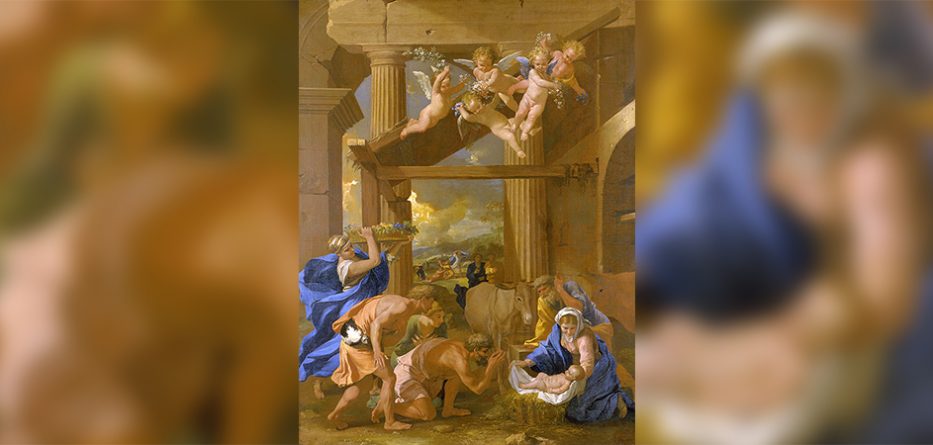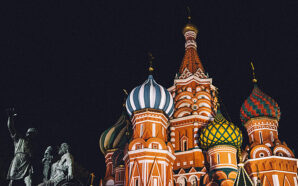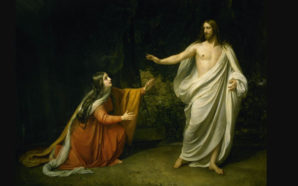The Word was made flesh, he lived among us. John 1:14
25 December 2019, The Nativity of the Lord
Readings:
Isaiah 52:7ŌĆō10, Psalm 97(98):1ŌĆō6, Hebrews 1:1ŌĆō6, John 1:1ŌĆō18
The moments between JesusŌĆÖ birth and his first cry must have felt like the eternity from which he was born. Jesus, held in the trembling arms of Mary, is the promise of an angel fulfilled. And then, God breathed.
God had breathed life into Adam in the garden (Gn 2:7) and all of Scripture is God-breathed (2 Tm 3:16), but this is different. God is truly Emmanuel, with us in all things except sinŌĆöeven in breath.
God has been speaking to us in many ways throughout salvation history (cf. Heb 1:1) but, as Pope Emeritus Benedict XVI tells us, ŌĆ£GodŌĆÖs dialogue with us becomes truly human, since God conducts his part as man.ŌĆØ
But, more than this, in coming down to us as one of us, Jesus draws us up into his life and shares with us a dignity unique in all of creationŌĆöwe become sons and daughters of the Father.
Amid the activities of today, take time to remember what your breathing says about you, considering this mystery of EmmanuelŌĆöGod with us.
Breathe in; I am loved with an everlasting love. Breathe out; nothing can separate me from the love of God in Christ Jesus. Breathe in; I am no longer a slave to sin and death. Breathe out; in Jesus, we are forgiven, redeemed and restored. Breathe in; I am a child of God. Breathe out; no greater gift do I have to offer the world than the truth of this.
Happy Christmas.
The Word was made flesh, he lived among us, and we saw his glory, the glory that is his as the only Son of the Father, full of grace and truth. Amen.
Peter Gilmore
Artwork Spotlight
The Adoration of the Shepherds ŌĆō Nicolas Poussin (1594ŌĆō1665)
ŌĆ£The Adoration of the ShepherdsŌĆØ, c. 1633ŌĆō1634. Oil on canvas, 97.2 x 74 cm. The National Gallery, London.
We already met Nicolas Poussin in 2015 with his Healing of the Blind of Jericho. He was the leading painter of the classical French Baroque style, although he spent most of his working life in Rome. Most of his works are on religious and mythological subjects, painting for a small group of Italian and French collectors, hence his emphasis on subjects pleasing to the eye.
He wavered between Paris and Rome, finally settling in Rome. In Paris, he had been First Painter to the King, but was unimpressed with the intrigues of court life. In his later years, he gave prominence to the landscapes in his pictures, evidenced in the painting we are examining, The Adoration of the Shepherds, circa A.D. 1633, and housed in the National Gallery of London.
Soon after it was painted, it was acquired by Cardinal Gian Carlo deŌĆÖ Medici, the second son of Grand Duke Cosimo II of Tuscany, and placed in his villa outside Florence. It was well-regardedŌĆö20 painted copies existing in the next century. Elements of the painting reflect Raphael.
The painting actually depicts two scenesŌĆöthe adoration of the shepherds in the foreground, but they are only the first on the scene following the Annunciation of the angel in the centre background. Behind the ass can be seen two shepherds running in haste to see the marvel predicted.
At the time of Christ, shepherds occupied a very low social status, but scripturally, their nomadic state was seen as conducive to the search for God, and thus they were more sensitive to his marvels.
In time, Christ would proclaim himself to be the Good Shepherd, for IsraelŌĆÖs shepherds had abandoned their flock. Not only would Christ be the true Pastor, he would become the Lamb sacrificed to save his flock from the wolf. The shepherds bow in humble adoration, fulfilling the prophecy of Isaiah: ŌĆ£Human pride will lower its eyes, the arrogance of men will be humbledŌĆØ (Is 2:11).
Poussin adds a very feminine quality. The figure in green between the two adoring shepherds is a woman, and on the extreme left a woman in a blue mantle bears a wicker basket of fruit, complementing the angels above who have gathered flowers from the field.
It reminds us of the prescription that Israel must present its first-fruits to God, as a reminder that he is the Lord of the harvestŌĆöIsraelŌĆÖs provider. We can never come empty-handed to Christ. ŌĆ£When you come to present yourselves before men.ŌĆ” cease to do evil. Learn to do good, search for justice, keep the oppressedŌĆØ (Is 1:12, 16ŌĆō17).
Notice that Poussin neatly frames the foreground with two women draped in blueŌĆöthe one bearing fruit on the left, and Mary on the right, cradling the Fruit of her womb. Of all women, she is the most blessed, for she gave herself. ŌĆ£I am the handmaid of the Lord. May his will be done in meŌĆØ (Lk 1:38). God could ask no more, and it was this offering which brought him to earth.
The main scene takes place in a large, but derelict, classical building (the left column shows signs of wear), to which a crude wooden lean-to stable has been added. So, while fulfilling the expected structure of a stable, the artist presents a twistŌĆöthe might of Rome will one day come crumbling down. ŌĆ£Mine is not a kingdom of this world,ŌĆØ (Jn 18:36) Jesus would say to Pilate.
Behind Mary, Joseph leans on his walking staff. Ever the provident provider, he knows that the Prince of Peace will not be left in peace. Herod is on the prowl and Joseph is the guardian of the Holy Family. SimeonŌĆÖs words must be brooding in his mind: ŌĆ£This child is destined for the fall and the rising of manyŌĆØ (Lk 2:34). Nothing is what it seems.
Monsignor Graham Schmitzer
Peter Gilmore has a background in youth and young adult ministry and currently works as a coordinator of CCD and evangelisation for the Office of Renewal and Evangelisation, Diocese of Wollongong. He has recently completed his studies in theology and currently supports parishes utilising the Divine Renovation and Alpha resources. He has a passion for making Church teaching and biblical truth accessible to all.
Monsignor Graham Schmitzer recently retired as the parish priest at Immaculate Conception Parish in Unanderra, NSW. He was ordained in 1969 and has served in many parishes in the Diocese of Wollongong. He was also chancellor and secretary to Bishop William Murray for 13 years. He grew up in Port Macquarie and was educated by the Sisters of St Joseph of Lochinvar. For two years, he worked for the Department of Attorney General and Justice before entering St ColumbaŌĆÖs College, Springwood, in 1962. Fr Graham loves travelling and has visited many of the major art galleries in Europe.
With thanks to the Diocese of Wollongong who have supplied the weekly Advent and Christmas 2019 reflections from their publication,┬ĀThe Way ŌĆō Advent & Christmas Daily Reflections 2019. You can read the reflections as they are published┬Āhere.








